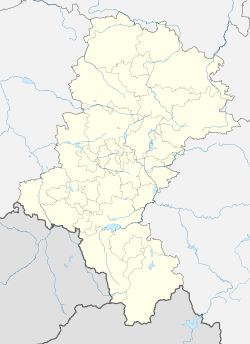Cieszyn
Cieszyn | |
|---|---|
 Cieszyn market square in November 2016 | |
| Motto(s): | |
| Coordinates:49°44′54.37″N18°37′59.56″E/ 49.7484361°N 18.6332111°E | |
| Country | |
| Voivodeship | |
| County | Cieszyn |
| First mentioned | 1155 |
| Government | |
| •Mayor | Gabriela Staszkiewicz |
| Area | |
| • Total | 28.69 km2(11.08 sq mi) |
| Elevation | 310 m (1,020 ft) |
| Population (31 December 2021[1]) | |
| • Total | 33,500 |
| • Density | 1,200/km2(3,000/sq mi) |
| Time zone | UTC+1(CET) |
| • Summer (DST) | UTC+2(CEST) |
| Postal code | 43-400 |
| Area code | +48 33 |
| Highways | |
| Voivodeship roads | |
| Website | http:// cieszyn.pl/ |
Cieszyn(/ˈtʃɛʃɪn/CHESH-in,Polish:[ˈt͡ɕɛʂɨn];Czech:Těšín[ˈcɛʃiːn];German:Teschen;Latin:Tessin;Silesian:Ćeszyn) is a border town in southernPolandon the east bank of theOlza River,and the administrative seat ofCieszyn County,Silesian Voivodeship.The town has 33,500 inhabitants (as of December 2021),[update][1]and lies oppositeČeský Těšínin theCzech Republic.Both towns belong to the historical region ofCieszyn Silesia,and formerly constituted the capital of theDuchy of Cieszynas a single town.
Geography[edit]

The town is situated on theOlzariver, a tributary of theOderRiver, which forms the border with theCzech Republic.It is located within the westernSilesian Foothillsnorth of theSilesian Beskidsand Mt.Czantoria Wielka,a popularski resort.Cieszyn is the heart of the historical region ofCieszyn Silesia,the southeasternmost part ofUpper Silesia.Until the end ofWorld War Iin 1918 it was a seat of theDukes of Cieszyn.
In 1920 Cieszyn Silesia was divided between the two newly created states ofPolandandCzechoslovakia,with the smaller western suburbs of Cieszyn becoming part of Czechoslovakia as a new town calledČeský Těšín.The larger part of the town joined Poland as Cieszyn.[2]Three bridges connect thetwin towns.After Poland and the Czech Republic joined theEuropean Unionand its passport-freeSchengen zone,border controls were abolished and residents of both the Polish and Czech part could move freely across the border. The combined population of Polish and Czech parts of the city is 61,201 inhabitants.[citation needed]Cieszyn is the southern terminus of the PolishNational road 1leading toGdańskon theBalticcoast.
The town combines both Polish andOld–Austrianpeculiarities in the style of its buildings. Because of several major fires and subsequent reconstructions (the last one in the late 18th century), the picturesque old town is sometimes calledLittle Vienna.[citation needed]The only relic of the ancient castle is a square tower, dating from the 14th century and 11th centuryromanesquechapel.[citation needed]
History[edit]

The area has been populated byWest Slavicpeoples since at least the 7th century. According to legend, in 810 three sons of a prince – Bolko, Leszko and Cieszko, met here after a long pilgrimage, found a spring, and decided to found a new settlement. They called it Cieszyn, from the wordscieszym się( "We're happy" ). This well can be found atulica Trzech Braci( "Three Brothers Street" ), just west of the town square.[3][4]
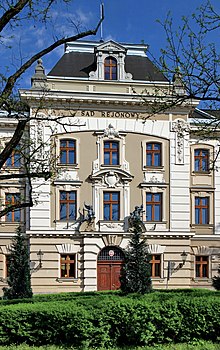
The area became part of the emerging Polish state in the 10th century. The town was the capital of theDuchy of Cieszyn,established during the fragmentation of Poland into smaller duchies, since 1290, which was ruled byPiast dynastyuntil 1653 and by theHabsburg Dynastyof Austria until 1918. It was in Teschen thatMaria TheresaandFrederick IIon in May 1779 signed theTeschen Peace Treaty,which put an end to theWar of the Bavarian Succession.In the 19th century Teschen was known for its ethnic, religious and cultural diversity, containing mostly German, Polish, Jewish and Czech communities.[5]There was also a small Vlach community[6]and aHungariancommunity in the town consisting mostly of officers and clerks.[7]
The town was divided in July 1920, by theSpa Conference,a body formed by theVersailles Treaty,leaving a Polish minority on the Czechoslovak side. Its smaller western suburbs became what is now the town ofČeský Těšínin theCzech Republic.During the interwar period two villages were merged into Cieszyn:Błogocicein 1923 andBobrekin 1932. After 1920 many ethnic Germans left the town, while many Poles from the Czechoslovakian part of the region moved in. According to the Polish census of 1921, Cieszyn had 15,268 inhabitants, of whom 9,241 (60.5%) were Poles, 4,777 (31.2%) were Germans, 1014 (6.6%) were Jews, and 195 (1.3%) were Czechs. The census from 1931 indicated 14,707 inhabitants, of whom 12,145 (82.7%) were Poles, while the rest consisted mostly of Germans and Jews (in 1937 estimated to be 12 and 8% respectively).[8]
Cieszyn and Český Těšín were merged again in October 1938 when Poland annexed theTrans-Olzaarea together with Český Těšín. Following the joint German-Sovietinvasion of Poland,which startedWorld War IIin September 1939, Cieszyn wasoccupied by Germanyuntil 1945. In 1939–1940, the Germans carried out mass arrests of local Poles during the genocidalIntelligenzaktioncampaign, and then imprisoned them in a newly established Nazi prison in the town.[9]Many Polish teachers, school principals, priests and activists were deported toconcentration campsand murdered there.[10]The Nazi prison had twoforced laboursubcamps in the town, and two more in nearbyKarvináandKonská.[11]The Germans also established a camp for children up to the age of 2-3, where they were beaten, tortured and subjected tomedical experiments.[12]Almost the entire Jewish community was murdered by the Nazis.
After World War II, the border between Poland and Czechoslovakia was restored to that of 1920. Most Germansfled or were expelledin accordance with thePotsdam Agreementand were replaced with Poles expelled from thePolish areas annexed by the Soviet Union.Signs of the former German presence in the town were removed by a special committee.[13]
On 19 July 1970, five firefighters from Cieszyn died when a bridge they were on fell into the Olza River, due to heavy flooding. In 1977,Boguszowice,Gułdowy,Kalembice,Krasna,Mnisztwo,Pastwiskawere amalgamated with Cieszyn andMarklowice.
Culture[edit]
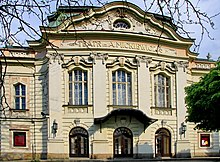
Since the 18th century Cieszyn Silesia has been an important centre of PolishProtestantismwhen theJesus Churchwas built as the only one inUpper Silesia.Currently, Cieszyn is also the site of the Cieszyn Summer Film Festival, one of the most influentialfilm festivalsin Poland. There is also an earlier established Czech-Polish-Slovak film festival.
Industry[edit]
Cieszyn is an important centre of the electromechanical industry. It is also the site of theOlza Cieszynsweets factory (where the famousPrince Polowafersare made) and theBrackie Browar,whereŻywiec Porteris brewed. The main source of income for many citizens is trade with the nearbyCzech Republicand retail trade associated with transit across the two bridges over theOlzato Český Těšín. In the past, the city was home to many furniture factories.[14]
Sites of interest[edit]
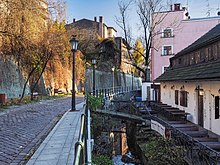
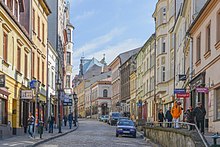
- Romanesque St. Nicholas' Chapel (Kaplica św. Mikołaja,arotundafrom the 11th century), depicted on the current20 złotych note.
- Remnants of thePiastdynasty castle
- Piast Castle Tower (Wieża Piastowska,mostly 14th century)
- GothicSt.Mary MagdaleneChurch (Kościół Marii Magdaleny,13th century), burial site of the Cieszyn line of the Piast dynasty
- Old Town Square (Rynek)
- bourgeoisiehouses (15th–19th centuries)
- Town Hall(Ratusz,early 19th century)
- Former minting house (18th century)
- LutheranChurch of Jesus(18th century)
- Museum ofCieszyn Silesiain the former Larisch family palace (Pałac Laryszów,Muzeum Śląska Cieszyńskiego,the first museum in Poland)
- Castle Brewery(Browar Zamkowy,1846)
- Habsburg Palace in Cieszyn
- Bonifraters Monastery (18th century)
- TheprotestantChurch of Jesus(Kościół Jezusowy), with abaroquetower and statues of theFour Evangelistsabove thealtarthat liven up the plain interior.
- Holy Cross Church
Notable people[edit]
- Jiří Třanovský(1592–1637), theologian andcomposer
- Adam Christian Agricola(1593–1645), evangelical preacher
- Carl Friedrich Kotschy(1789–1856),botanistandtheologian
- Friedrich Uhl(1825–1906),journalist,writer
- Jakub Skrobanek(born c. 1835–1910), merchant, banker and mayor of Cieszyn
- Rudolf Ramek(1881–1941), Austrian politician,Chancellor of Austria
- Jan Łysek(1887–1915), writer
- Hermann Heller(1891–1933), jurist
- Viktor Ullmann(1898–1944), Jewish musician
- Max Rostal(1905–1991), violinist and educator
- Herbert Czaja(1914–1997), German politician (CDU)
- Richard Pipes(1923–2018), Polish-American historian,Harvard UniversityProfessor
- Inge Mahn (born 1943), German sculptor, professor
- Jadwiga Smykowska(1945–2017), artist
- Karol Semik(born 1953), teacher and educator
- Magdalena Gwizdoń(born 1979),biathlete
- Kajetan Kajetanowicz(born 1979), rally driver
- Ireneusz Jeleń(born 1981), footballer
- Tomisław Tajner(born 1983),ski jumper
- Jan Błachowicz(born 1983),mixed martial artistand formerUFCLight Heavyweight Champion
- Piotr Żyła(born 1987), ski jumper, world champion
- Kacper Sztuka(born 2006), racing driver
Twin towns – sister cities[edit]
Gallery[edit]
-
Town Hall at the Cieszyn Market Square
-
Townhouses in Cieszyn
-
Rotunda from circa 1180 / St. Nicholas Church
-
14th centuryPiasttower
-
Statue ofSaint Florian
-
Monastery, church, and hospital of theSisters of Saint Elizabeth
-
Mary MagdaleneDominican Church, begun in late 13th century
-
Hunting Palace of the Habsburgsand monument commemorating Silesian legionnaries fallen for Poland
-
Hotel on the town square
-
EvangelicalProtestantChurch of Jesus,begun in 1710
-
Communal Cemetery in Cieszyn
-
Museum of theCieszyn Silesia
References[edit]
- ^ab"Local Data Bank".Statistics Poland.Retrieved2022-07-27.Data for territorial unit 2403011.
- ^Edmund Jan Osmańczyk, Anthony Mango (2003).Encyclopedia of the United Nations and international agreements - Volume 1 A-F(2003 ed.).Taylor & Francis.p. 382.ISBN0-415-93921-6.
- ^"Cieszyn - Tourism | Tourist Information - Cieszyn, Poland".Staypoland.Retrieved2013-07-16.
- ^The legend is inscribed on theWell of the Three Brothers[permanent dead link]in Cieszyn.
- ^Wawreczka et al. 1999, 13.
- ^Václav Davídek, “Osidlení Tešinska Valahy”, Praha, 1940
- ^Wawreczka et al. 1999, 10.
- ^Dzieje Cieszyna..., 2010, t. III, p. 323
- ^Wardzyńska, Maria (2009).Był rok 1939. Operacja niemieckiej policji bezpieczeństwa w Polsce. Intelligenzaktion(in Polish). Warszawa:IPN.p. 139.
- ^Wardzyńska, pp. 137–141
- ^"Strafgefängnis und Stammlager Teschen".Bundesarchiv.de(in German).Retrieved16 October2023.
- ^Kostkiewicz, Janina (2020). "Niemiecka polityka eksterminacji i germanizacji polskich dzieci w czasie II wojny światowej". In Kostkiewicz, Janina (ed.).Zbrodnia bez kary... Eksterminacja i cierpienie polskich dzieci pod okupacją niemiecką (1939–1945)(in Polish). Kraków:Uniwersytet Jagielloński,Biblioteka Jagiellońska.p. 58.
- ^Dzieje Cieszyna..., 2010, t. III, p. 439–440
- ^.Encyclopædia Britannica.Vol. 26 (11th ed.). 1911.
- ^"Miasta partnerskie".cieszyn.pl(in Polish). Cieszyn.Retrieved2020-03-12.
Further reading[edit]
- Chisholm, Hugh,ed. (1911)..Encyclopædia Britannica.Vol. 26 (11th ed.). Cambridge University Press. p. 664.
- Panic, Idzi,ed. (2010).Dzieje Cieszyna od pradziejów do czasów współczesnych[History of Cieszyn from Ancient to Modern Times]. Vol. 1–3. Cieszyn:Książnica Cieszyńska.ISBN978-83-927052-6-0.
- Wawreczka, Henryk;Janusz Spyra;Mariusz Makowski (1999).Těšín, Český Těšín na starých pohlednicích a fotografiích / Cieszyn, Czeski Cieszyn na starych widokówkach i fotografiach.Nebory, Třinec: Wart.ISBN80-238-4804-6.
- Długajczyk, Edward(1993).Tajny front na granicy cieszyńskiej. Wywiad i dywersja w latach 1919-1939.Katowice: Śląsk.ISBN83-85831-03-7.
External links[edit]
![]() Media related toCieszynat Wikimedia Commons
Media related toCieszynat Wikimedia Commons
- Official website
- Museum of Cieszyn Silesia(Muzeum Śląska Cieszyńskiego)
- Jewish Community in Cieszynon Virtual Shtetl




